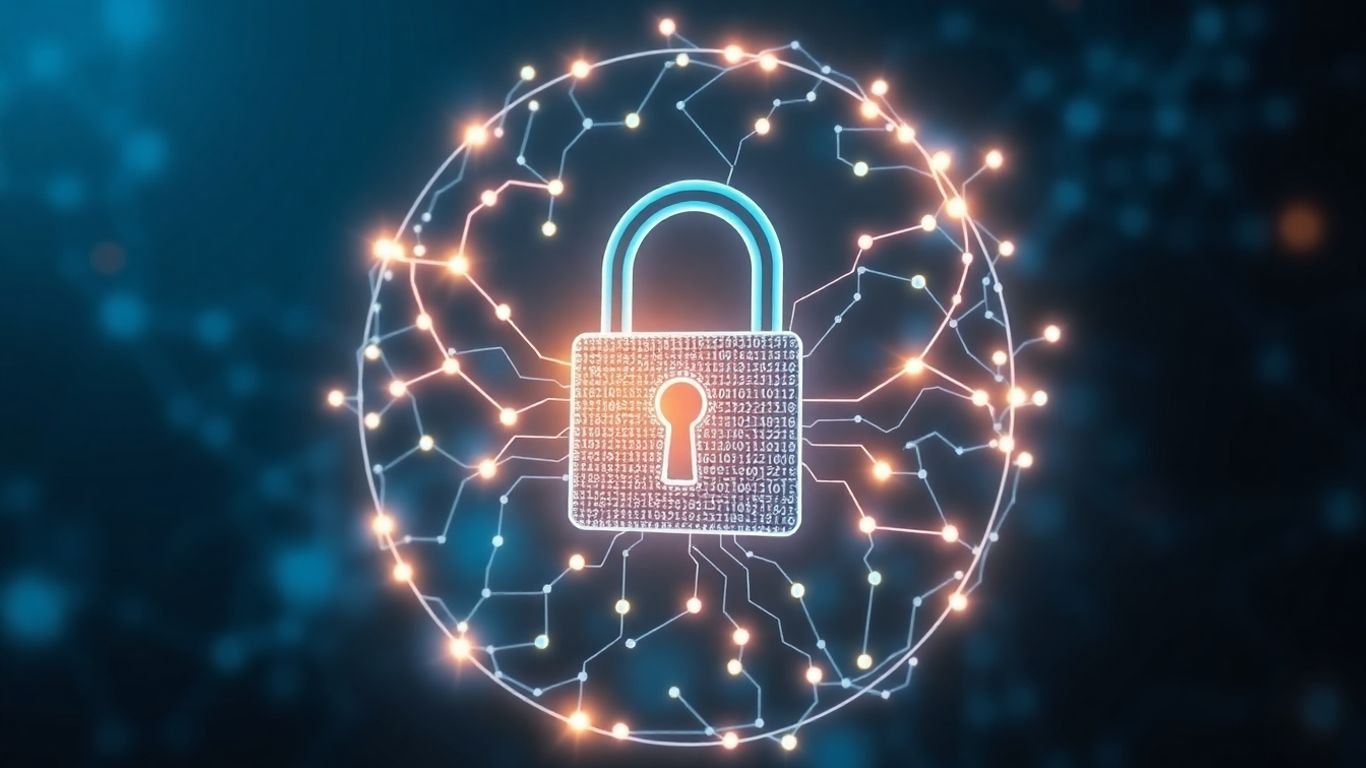Data Privacy and Security in the AI Era: Expert Insights & Safeguards

Artificial intelligence is changing a lot of things, and with that comes new worries about our personal information. We’re going to talk about Data Privacy & Security in the AI Era, looking at what’s happening, what the problems are, and how we can try to keep our data safe. It’s a big topic, and it affects everyone.
Key Takeaways
- AI needs a lot of personal data to work, making data privacy a big deal these days. Knowing why data privacy matters helps both people and companies.
- AI brings privacy problems like using data without permission, issues with things like fingerprints or faces, collecting info secretly, and unfairness in how AI makes decisions.
- Real examples of AI privacy problems, like data getting stolen, using AI for watching people, or AI making biased choices, show we really need rules and better ways to handle data.
- To keep data safe with AI, we need to collect less information, only keep it for a set time, get clear permission to use it, follow good security steps, and protect sensitive data extra carefully.
- Good ways to protect privacy when using AI include having clear rules for data, building privacy into systems from the start, and making sure we can see and control how data is used.
Understanding Data Privacy in the AI Era
Artificial intelligence is changing a lot of things, and with that comes new questions about our personal information. It’s not just about keeping your bank details safe anymore; it’s about how AI systems learn and make decisions using data that might be about you. This whole area of data privacy has become way more complicated.
The Significance of Data Privacy
Think about data privacy as your right to control who sees and uses your personal stuff. In today’s world, where so much of our lives is online, this control is super important. It helps build trust between people and the companies they interact with. When organizations are good at protecting data, people feel more comfortable sharing what they need to. It’s not just about avoiding identity theft or financial loss, though those are big worries. It’s also about protecting your reputation and your peace of mind. Being transparent about how data is handled and having solid security measures in place makes a big difference. It shows you respect people’s information.
How AI Technologies Utilize Personal Data
AI systems, at their core, need data to work. They learn from it, find patterns, and then make predictions or decisions. This can be anything from suggesting what movie you might like next to helping decide if you qualify for a loan. The more data an AI has, often the better it performs. But this is where things get tricky. AI can process vast amounts of personal information, sometimes in ways we don’t fully grasp. This raises questions about how our data is being collected, who gets to see it, and what the long-term effects might be on our privacy and our freedom to make choices.
Evolving Perceptions of Data Privacy
Years ago, most people thought about data privacy in terms of online shopping – maybe not caring too much if a company knew what they bought. It could even be helpful sometimes. But now, with AI collecting data everywhere, all the time, to train these systems, people are starting to see the bigger picture. This widespread data collection can have a huge impact on society, affecting things like civil rights. We’re seeing a shift in how people view their data; there’s a growing expectation for more control and transparency. It’s a complex landscape, and understanding the spectrum of data-protection challenges in AI is key to navigating it within this complex landscape.
The way AI uses data means we need to think differently about privacy. It’s not just about preventing bad actors from stealing information, but also about how legitimate systems might use data in ways that were never intended or agreed upon, impacting individuals and society broadly.
Key Privacy Challenges Posed by AI

AI is pretty amazing, but it also brings some tricky privacy problems to the table. It’s not just about keeping data safe; it’s about how that data is collected, used, and what happens when things go wrong. We’re talking about some serious stuff here, and it’s important to get a handle on it.
Unauthorized Data Use and Collection Practices
This is a big one. Lots of AI systems gobble up personal information, and often, people don’t really know or agree to how it’s all being used. It’s like giving away your diary without reading it first. This can lead to your details being shared or exploited in ways you never intended. Many platforms are pretty vague about how they gather and share information, which really messes with trust. When data is taken without a clear ‘yes,’ you might find yourself bombarded with ads, unfairly profiled, or even facing identity theft. We need clearer rules and easier ways for people to say ‘no’ or to delete their information if they want to. It’s about giving people back some control.
Biometric Data Concerns
Think about fingerprints, facial scans, or even how you walk. AI is getting really good at recognizing these unique traits. While it can be useful for things like unlocking your phone, it also opens up a whole new can of worms. This kind of data is incredibly personal and, once compromised, can’t be changed like a password. Imagine your face being used in ways you never agreed to, or your gait being tracked without your knowledge. The potential for misuse, especially in surveillance, is pretty significant. We need to be extra careful about how this sensitive information is handled and protected.
Algorithmic Bias and Discrimination
AI learns from the data it’s fed. If that data reflects existing societal biases – and let’s be honest, a lot of it does – the AI will learn those biases too. This can lead to unfair outcomes. For example, an AI used for hiring might unfairly screen out certain candidates based on factors unrelated to their qualifications, simply because the historical data it learned from was biased. Or, AI used in law enforcement could disproportionately flag individuals from specific communities. This isn’t just a technical glitch; it’s a real-world problem that can perpetuate and even amplify discrimination.
The speed and scale at which AI operates mean that privacy violations can happen much faster and affect far more people than traditional methods. What might have taken months to uncover manually could be discovered and exploited by AI in minutes.
Here are some of the ways these challenges manifest:
- Data Exfiltration: Hackers can trick AI systems into revealing sensitive information they shouldn’t. Think of a clever prompt that makes an AI assistant spill confidential company documents.
- Data Leakage: Sometimes, AI systems accidentally expose private data. A recent example involved a popular AI chatbot showing users conversation histories that weren’t theirs.
- Surveillance Amplification: AI can analyze vast amounts of surveillance data, like security camera footage, to track individuals on a massive scale, raising serious privacy questions about constant monitoring. This is a major concern for individual privacy.
The Real Risk: AI Exposing Existing Gaps
It’s easy to point fingers at AI and say it’s the source of all our new data privacy headaches. But honestly, AI isn’t really creating these problems from scratch. Instead, it’s like a super-powered magnifying glass, showing us all the weak spots and security holes that have been lurking in our systems for ages. The real danger is how fast and how widely AI can exploit these pre-existing issues. Think of it like this: a small leak in your roof might go unnoticed for a while, but a hurricane will reveal its true extent in no time. AI is that hurricane for data security.
Data Over-Sharing in AI Systems
AI systems, especially large language models (LLMs), are hungry for data. They need vast amounts to learn and perform. This hunger can lead to systems inadvertently collecting or being fed more information than necessary. Sometimes, this happens because users, trying to get better results, feed the AI more detailed personal or company information. Other times, it’s a result of how the AI is designed or how data flows into it. Without strict controls, sensitive details can easily get mixed into training sets or outputted in ways that weren’t intended. It’s like leaving the back door open when you’re just trying to get a bit more air in the room.
Speed and Scale of AI-Driven Risks
The sheer speed and scale at which AI operates amplify existing risks dramatically. What might have taken a human analyst weeks to uncover or exploit could be done by an AI in minutes. This rapid processing means that a single vulnerability can be leveraged across millions of data points almost instantly. This also applies to how AI can be used for surveillance; analyzing camera feeds or online activity at a scale previously unimaginable. This speed means that by the time you realize there’s a problem, the damage might already be widespread.
Compliance Violations and Loss of Trust
When AI systems expose data gaps, the consequences can be severe. Organizations might find themselves in violation of data protection laws like GDPR or CCPA, leading to hefty fines and legal battles. Beyond the financial penalties, there’s the significant damage to reputation. Customers and partners entrust companies with their data, and a breach, especially one facilitated by AI, erodes that trust. Rebuilding that confidence is a long and difficult road, and sometimes, it’s a road a company never fully recovers from.
The core issue isn’t that AI is inherently malicious, but that it operates at a speed and scale that can quickly overwhelm existing, often inadequate, security and privacy measures. It highlights the urgent need to address foundational data management and security practices before fully embracing advanced AI capabilities.
Here are some ways AI exposes these gaps:
- Unintended Data Exposure: AI models can sometimes reveal snippets of their training data, including personal information, through clever prompting or unexpected outputs. This is often accidental but still a breach.
- Amplified Surveillance: AI can analyze vast amounts of surveillance data (like CCTV footage or online activity) to identify patterns or individuals, raising concerns about mass monitoring.
- Algorithmic Bias: If the data used to train an AI is biased, the AI’s decisions will also be biased, potentially leading to unfair outcomes in areas like hiring, loan applications, or even law enforcement.
- Data Exfiltration: Malicious actors can use AI systems themselves, or exploit vulnerabilities within them, to steal sensitive data more efficiently than traditional methods.
| Risk Area | AI’s Amplification Factor | Potential Impact |
|---|---|---|
| Data Collection | High | Unauthorized access, privacy violations |
| Data Usage | Very High | Reputational damage, regulatory fines |
| Data Storage | Medium | Increased vulnerability to breaches |
| Algorithmic Decision-Making | High | Discrimination, loss of public trust |
Safeguarding Data in the Age of AI
Look, AI is pretty amazing, but it also means we have to be extra careful about our personal information. It’s not that AI is inherently bad, it’s just that it can find and use data in ways we haven’t seen before. So, what can we actually do to keep our data safe?
Limiting Data Collection and Establishing Retention Timelines
It sounds simple, but it’s a big one: don’t collect data you don’t absolutely need. Think about it, the less data out there, the less there is to lose. Companies should really stick to collecting only what’s necessary for a specific task. And once that task is done, the data should be deleted. Setting clear rules for how long data is kept is super important. This means having a plan to get rid of old information promptly, rather than letting it pile up indefinitely. It’s about being mindful of what you’re holding onto and for how long.
Seeking Explicit Consent for Data Usage
This is where things get personal. People should know exactly what they’re agreeing to when they share their information. It’s not enough to hide it in a long, complicated privacy policy. Companies need to be upfront and clear about how they plan to use your data, especially if they’re using AI to do it. If the way the data is used changes, they should ask for permission again. Giving people real control over their information is key to building trust. This means making it easy for individuals to say ‘yes’ or ‘no’ to how their data is handled, and also making it simple to change their minds later.
Following Security Best Practices
This is the bread and butter of keeping any data safe, AI or not. It means using strong passwords, keeping software updated, and being smart about who gets access to what. For AI systems, this also involves things like encryption, which scrambles data so it can’t be read by unauthorized people, and anonymization, which removes personal identifiers. Think of it like locking your doors and windows, but for your digital information. It’s about putting up as many barriers as possible to prevent unwanted access or leaks. You can find more information on best practices for data privacy.
Enhanced Protection for Sensitive Data Domains
Some types of data are just more sensitive than others. We’re talking about things like your health records, your job history, your financial details, or information about your education. Data related to children also falls into this category. AI systems that handle this kind of information need extra layers of security and very strict rules about how they can be used. This data should only be accessed and processed in very specific, limited situations. It’s like putting a special lock on a very important box – you don’t want just anyone getting their hands on it.
The speed and scale at which AI operates mean that any existing security weaknesses can be exposed much faster and more widely than before. This makes having solid data protection strategies not just a good idea, but a necessity.
Best Practices for Protecting Privacy in AI Applications
So, you’ve built this cool AI thing, and now you’re wondering how to keep everyone’s data safe. It’s not just about following the rules; it’s about not freaking people out with how you handle their information. Think of it like this: you wouldn’t leave your front door wide open, right? Same idea here, but with digital stuff. We need to be smart about it from the get-go.
Developing Strong Data Governance Policies
This is basically the rulebook for your data. It tells everyone what data you’re allowed to collect, how long you can keep it, who gets to see it, and what you can and can’t do with it. Without a solid set of rules, things can get messy fast. It’s like trying to play a game without knowing the rules – chaos.
- Data Classification: Figure out what kind of data you have. Is it just public stuff, or is it super sensitive like health records?
- Access Controls: Make sure only the right people can access certain data. No random employees should be poking around in customer files.
- Regular Audits: Periodically check to see if everyone is actually following the rules. This helps catch problems before they become big ones.
- Compliance Alignment: Keep your policies in line with laws like GDPR or CCPA. These aren’t just suggestions; they’re legal requirements.
Leadership really needs to be on board with this. If the bosses don’t care, nobody else will. It’s about building a culture where data protection is just part of the job, not an afterthought.
Implementing Privacy by Design Principles
This means thinking about privacy before you even start building your AI. It’s way easier to build privacy in from the start than to try and bolt it on later. Imagine trying to add a steering wheel to a car after it’s already built – not going to work well.
- Minimize Data Collection: Only grab the data you absolutely need. Don’t hoard information just in case you might need it someday. If you don’t need it, don’t collect it.
- Set Retention Limits: Decide how long you’ll keep data and stick to it. Get rid of it when you don’t need it anymore. Less data hanging around means less risk.
- Get Clear Consent: Ask people directly if it’s okay to use their data, especially if you plan to use it for something new. Don’t assume they’re cool with it.
- Secure Everything: Use good security practices. Think encryption, anonymization, and making sure only authorized systems can access the data. It’s like putting locks on your digital doors.
Ensuring Visibility and Control Over Data Usage
People should know what you’re doing with their data, and they should have some say in it. If you’re using AI to make decisions about them, they deserve to understand how that works and have a way to correct mistakes.
- Transparency: Be upfront about what data you collect and how your AI uses it. No hidden agendas.
- User Access: Give people a way to see the data you have on them. They might want to check it for accuracy.
- Correction Mechanisms: If the data is wrong, provide a simple way for people to fix it. This is especially important if AI is making important decisions based on that data.
- Opt-Out Options: Where possible, let people opt out of certain types of data collection or AI processing. Giving people choices builds trust.
Real-World Instances of AI Privacy Issues

It’s easy to talk about data privacy in theory, but seeing how things can go wrong in practice really drives the point home. AI, with its hunger for data and its complex workings, has unfortunately shown us a few times how vulnerable our personal information can be. These aren’t just abstract risks; they’re real events that have affected people and made us all think harder about how we use and protect data.
High-Profile Data Breaches Involving AI
We’ve seen some pretty big data breaches lately, and AI has been right in the middle of them. Sometimes, it’s the AI systems themselves that get targeted, or maybe the vast amounts of data they process become a juicy target for hackers. These incidents often expose weak spots in how companies are securing information, leaving millions of people’s details exposed. Think about a healthcare company using AI to help with diagnoses. If that system isn’t locked down tight, patient records could end up in the wrong hands. It’s not just about financial loss; it’s about trust. When sensitive information like health records or financial details are compromised, it shakes people’s confidence in the technology they rely on.
The Use of AI in Surveillance and Law Enforcement
AI is also changing how we’re watched, both by governments and private companies. Facial recognition technology, for example, powered by AI, is used in public spaces and by law enforcement. While the idea is often to improve safety, it brings up big questions about privacy. Are we okay with being identified and tracked everywhere we go? AI can analyze video feeds from thousands of cameras, spotting patterns and identifying individuals at a scale never before possible. This can lead to concerns about overreach and the potential for misuse, especially when combined with other data sources.
Consequences of AI Privacy Violations
When AI privacy goes wrong, the fallout can be significant. It’s not just about a company getting a slap on the wrist from regulators. For individuals, it can mean:
- Identity theft: Stolen personal data can be used to impersonate someone.
- Discrimination: Biased AI systems, trained on flawed data, can lead to unfair treatment in areas like job applications or loan approvals.
- Erosion of trust: Repeated privacy failures make people hesitant to adopt new technologies or share their information online.
- Reputational damage: For companies, a major privacy violation can severely harm their brand and customer loyalty.
The speed and scale at which AI operates mean that privacy violations can happen much faster and affect far more people than traditional methods. What might have taken months to uncover manually could be discovered or exploited by AI in minutes. This rapid escalation demands equally rapid and robust security responses.
We’ve also seen instances where data collected for one purpose, like medical photos for a patient’s file, ended up being used to train AI models without the patient’s explicit knowledge. It highlights how important it is to be clear about data usage and to get proper consent, not just for the initial collection but for any subsequent use, especially when AI is involved.
Moving Forward Responsibly
So, we’ve talked a lot about how AI is changing things, and yeah, it’s pretty amazing. But it’s also clear that we can’t just jump in without thinking. Keeping our personal information safe is a big deal, and AI makes that even more complicated. It’s not just about following rules like GDPR; it’s about building trust. When companies are upfront about how they use data and put real protections in place, people feel more comfortable. We’ve seen how things can go wrong with data breaches and sneaky data collection, and that’s not good for anyone. The key is to be smart about it – collect only what’s needed, get clear permission, and keep data secure. It’s a constant effort, but by focusing on privacy from the start and being honest with people, we can make sure AI helps us without hurting us.
Frequently Asked Questions
What is data privacy and why is it important with AI?
Data privacy is all about keeping your personal information safe and giving you control over who uses it and how. With AI, which uses tons of data to learn and make decisions, protecting this information becomes super important. It helps prevent bad things like identity theft and builds trust between people and companies.
How does AI use my personal information?
AI systems learn by looking at huge amounts of data. This can include things you do online, like what you buy or search for. AI uses this information to do things like suggest products you might like or even make decisions about loans. The tricky part is making sure this data is used fairly and safely.
What are some privacy problems AI can cause?
AI can sometimes collect or use data without people knowing or agreeing. It can also be biased, meaning it might treat some groups of people unfairly. Plus, AI can sometimes make it easier for sensitive information, like your health details or face scans, to be exposed.
Can AI make privacy problems worse?
AI doesn’t usually create brand new privacy problems, but it can make existing ones much bigger and faster. Because AI can handle so much data so quickly, mistakes or bad uses of data can affect many more people in a shorter amount of time.
How can companies protect my data when using AI?
Companies should be careful about how much data they collect and for how long they keep it. They need to ask for your clear permission before using your data, especially for new things. Following good security rules, like using strong passwords and keeping software updated, is also key. Special care should be taken with very sensitive data, like health or financial information.
What happens when AI causes privacy issues?
When AI causes privacy problems, it can lead to serious consequences. This includes big data leaks where lots of personal information gets stolen, or AI being used for spying in ways that feel unfair. Companies can face fines, lose customers’ trust, and damage their reputation.






